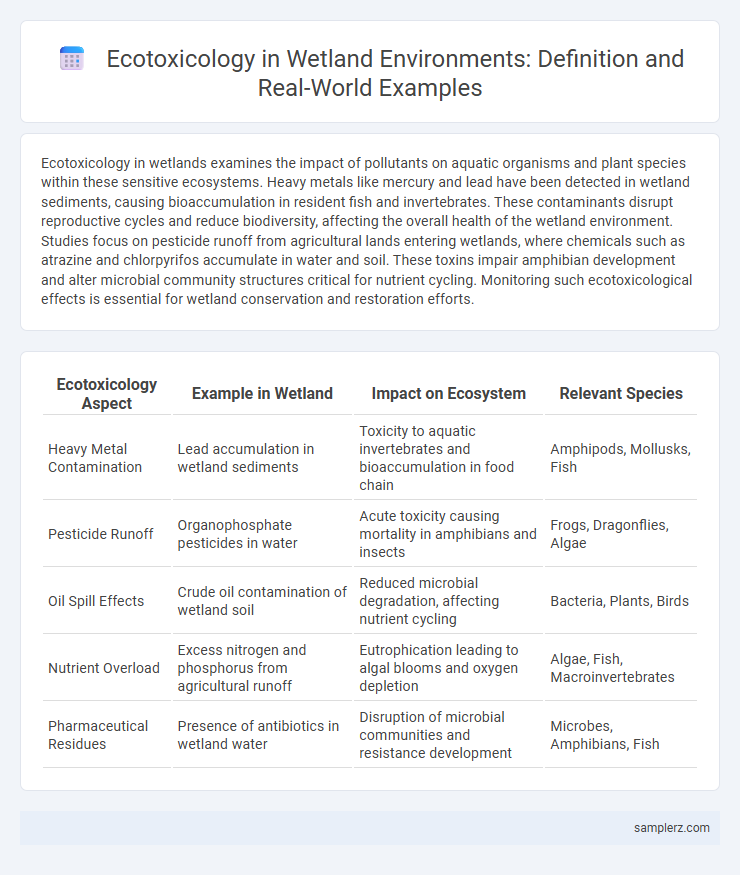Ecotoxicology in wetlands examines the impact of pollutants on aquatic organisms and plant species within these sensitive ecosystems. Heavy metals like mercury and lead have been detected in wetland sediments, causing bioaccumulation in resident fish and invertebrates. These contaminants disrupt reproductive cycles and reduce biodiversity, affecting the overall health of the wetland environment. Studies focus on pesticide runoff from agricultural lands entering wetlands, where chemicals such as atrazine and chlorpyrifos accumulate in water and soil. These toxins impair amphibian development and alter microbial community structures critical for nutrient cycling. Monitoring such ecotoxicological effects is essential for wetland conservation and restoration efforts.
Table of Comparison
| Ecotoxicology Aspect | Example in Wetland | Impact on Ecosystem | Relevant Species |
|---|---|---|---|
| Heavy Metal Contamination | Lead accumulation in wetland sediments | Toxicity to aquatic invertebrates and bioaccumulation in food chain | Amphipods, Mollusks, Fish |
| Pesticide Runoff | Organophosphate pesticides in water | Acute toxicity causing mortality in amphibians and insects | Frogs, Dragonflies, Algae |
| Oil Spill Effects | Crude oil contamination of wetland soil | Reduced microbial degradation, affecting nutrient cycling | Bacteria, Plants, Birds |
| Nutrient Overload | Excess nitrogen and phosphorus from agricultural runoff | Eutrophication leading to algal blooms and oxygen depletion | Algae, Fish, Macroinvertebrates |
| Pharmaceutical Residues | Presence of antibiotics in wetland water | Disruption of microbial communities and resistance development | Microbes, Amphibians, Fish |
Introduction to Ecotoxicology in Wetland Ecosystems
Ecotoxicology in wetland ecosystems examines the impact of pollutants such as heavy metals, pesticides, and industrial chemicals on aquatic plants, invertebrates, and fish species. Wetlands act as natural filters but can accumulate toxic substances that disrupt biological processes and biodiversity. Understanding the bioaccumulation and biomagnification of contaminants in wetland food webs is crucial for assessing ecological health and guiding conservation efforts.
Common Sources of Contaminants in Wetlands
Common sources of contaminants in wetlands include agricultural runoff containing pesticides and fertilizers, industrial discharges with heavy metals and toxic chemicals, and urban stormwater carrying hydrocarbons and nutrients. These pollutants disrupt aquatic ecosystems, harming plant and animal species and altering habitat quality. Monitoring and managing these contamination sources is crucial for preserving wetland biodiversity and ecological functions.
Heavy Metal Pollution and Its Impact on Wetland Species
Heavy metal pollution in wetlands poses significant ecotoxicological risks to aquatic and terrestrial species, disrupting ecological balance and biodiversity. Metals such as mercury, lead, and cadmium accumulate in wetland sediments and bioaccumulate in plants and animals, leading to toxic effects like impaired reproduction and growth inhibition. Monitoring heavy metal concentrations in wetland ecosystems is crucial for assessing environmental health and implementing remediation strategies to protect vulnerable species.
Pesticide Runoff Effects on Wetland Biodiversity
Pesticide runoff in wetlands significantly disrupts biodiversity by contaminating water and sediment, leading to toxic effects on aquatic plants, invertebrates, and amphibians. Studies reveal that organophosphate and pyrethroid pesticides reduce populations of sensitive species such as macroinvertebrates and amphibians, which play crucial roles in wetland ecosystems. The decline in these organisms compromises nutrient cycling and food web dynamics, resulting in long-term ecological imbalances.
Pharmaceutical Residues in Wetland Food Webs
Pharmaceutical residues in wetland food webs pose significant ecotoxicological risks by accumulating in aquatic organisms such as fish, amphibians, and invertebrates, disrupting endocrine functions and reproductive systems. Studies demonstrate that compounds like antibiotics and antidepressants persist in wetland sediments and bioaccumulate through trophic levels, leading to altered behavior and reduced survival rates in top predators. Monitoring these residues is critical for assessing ecological health and formulating strategies to mitigate contamination in wetland ecosystems.
Oil Spills and Hydrocarbon Contamination in Wetlands
Oil spills in wetlands release hydrocarbons that disrupt aquatic ecosystems by contaminating water and sediment, harming plant and animal life. These hydrocarbons persist in wetland soils, bioaccumulate in organisms, and impair critical biological functions, leading to reduced biodiversity and altered food webs. Monitoring ecotoxicological effects in wetland environments helps assess the long-term impact of hydrocarbon contamination and guides remediation efforts.
Nutrient Overload and Eutrophication in Wetland Areas
Nutrient overload in wetland areas often results from excessive nitrogen and phosphorus inputs, primarily from agricultural runoff and wastewater discharge. This influx triggers eutrophication, characterized by rapid algal blooms that deplete oxygen levels, harming aquatic species and disrupting ecosystem balance. Monitoring nutrient concentrations and implementing buffer zones are critical strategies to mitigate eutrophication's adverse effects on wetland biodiversity and water quality.
Bioaccumulation of Toxins in Aquatic Organisms
Bioaccumulation of toxins in aquatic organisms within wetlands poses significant ecological risks, as contaminants like heavy metals and pesticides concentrate in fish and invertebrates over time. These accumulated toxins can disrupt physiological functions, reduce reproductive success, and alter food web dynamics, threatening biodiversity and wetland ecosystem stability. Monitoring bioaccumulation patterns in species such as amphibians and crustaceans is crucial for assessing wetland health and guiding remediation efforts.
Case Studies: Notable Ecotoxicology Incidents in Wetlands
In the Florida Everglades, extensive pesticide runoff, particularly from agricultural sources, caused significant bioaccumulation of organochlorines in wetland species such as American alligators, leading to reproductive abnormalities and population declines. The Banc d'Arguin National Park in Mauritania witnessed heavy metal contamination, notably mercury from nearby mining activities, resulting in toxic impacts on aquatic invertebrates and migratory bird populations. Another notable incident occurred in Canada's Hudson Bay, where polychlorinated biphenyls (PCBs) accumulated in wetland sediments and trophic levels, disrupting fish health and reducing biodiversity in key wetland ecosystems.
Strategies for Monitoring and Mitigating Ecotoxicological Risks in Wetlands
Strategies for monitoring ecotoxicological risks in wetlands involve employing bioindicator species such as aquatic invertebrates and amphibians to detect pollutant accumulation and physiological stress. Advanced techniques like passive sampling devices and remote sensing provide continuous data on contaminant levels and habitat changes, facilitating early detection of toxic threats. Implementing phytoremediation with native wetland plants and controlled water management practices helps mitigate contamination, restoring ecosystem health and biodiversity.

example of ecotoxicology in wetland Infographic
 samplerz.com
samplerz.com